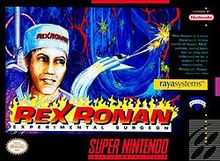Rex Ronan: Experimental Surgeon
| Rex Ronan: Experimental Surgeon | |
|---|---|
 Cover art of Rex Ronan: Experimental Surgeon | |
| Developer(s) | Sculptured Software[1] |
| Publisher(s) | Raya Systems[1] |
| Designer(s) | Craig Conder |
| Platform(s) | SNES |
| Release date(s) | |
| Genre(s) | Educational, action |
| Mode(s) | Single-player |
Rex Ronan: Experimental Surgeon is an educational action video game developed by Sculptured Software and published by Raya Systems for the Super Nintendo Entertainment System. The game teaches players about the hazards of smoking tobacco cigarettes.[2][3] The initial development of the game received support from the US Agency for Healthcare Research and Quality.[4] It is a part of educational video game series from Raya that includes Captain Novolin, Packy and Marlon and Bronkie the Bronchiasaurus.
Story and Gameplay
Jake Westboro is a man with it all: wife, a kid and a house in the suburbs. He also has a job with the Blackburn Tobacco Company.[2] As a result of smoking since he was 15, Jake is dying from the cigarettes that he once sold; the player must help the near-microscopic surgeon Rex Ronan travel inside of Jake's body and remove tar, nicotine, precancerous cells, and other health hazards that are preventing Jake from speaking to the world about the hazards of tobacco.[2][3] If the player (Rex Ronan) dies from the evil microbots that were sent by the tobacco company,[5] so does the patient (Jake.)[2]
Evaluations
Richard M. Satava mentioned two evaluations in which a number of children (none of whom were more than 12 years old) played a prototype version of the game.[3] The average of the results indicated children who experienced enjoyment and who also showed an interest with regard to acquiring information about tobacco's effects on people.[3] According to Richard L. Street and Timothy R. Manning, the target audience was children and teenagers in the age range of 10 to 16 years.[5] In addition, when it comes to persons who take up smoking, those in the age range of 10 to 16 years are at the highest risk, according to Street and Manning.[5]
| Reception | ||||||
|---|---|---|---|---|---|---|
| ||||||
References
- ↑ 1.0 1.1 1.2 "Release information". GameFAQs. Retrieved 2008-09-27.
- ↑ 2.0 2.1 2.2 2.3 "Game summary". Lil_Randy (GameFAQs). Retrieved 2008-10-15.
- ↑ 3.0 3.1 3.2 3.3 Satava, Richard M. (1995), Interactive technology and the new paradigm for healthcare, IOS Press (retrieved via Google Books), p. 207, retrieved 2010-11-18
- ↑ "Patient Education: Interactive video games can motivate health behavior change in children and adolescents". Agency for Healthcare Research and Quality. 2001. Retrieved 2011-02-12.
- ↑ 5.0 5.1 5.2 Street, Richard L. and Manning, Timothy R. (1997), Health promotion and interactive technology: theoretical applications and future directions, Psychology Press (retrieved via Google Books), p. 105, retrieved 2010-11-17